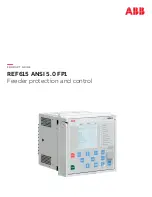
Overcurrent Protection 50, 51, 50N, 51N
Overcurrent protection is the main protection function of the 7SJ62/64 relay. Each phase current and the
ground current is provided with four elements. All elements are independent from each other and can be
combined as desired.
7SJ62/64
The high-set elements 50-3 and 50-2 as well as the overcurrent element 50-1 always operate with definite
tripping time, the fourth element 51 always with inverse tripping time.
Applications
•
The non-directional overcurrent protection is suited for radial systems with single-side infeed or open
ring systems, for backup protection of all kinds of comparison protection equipment for lines, trans-
formers, generators, motors, and busbars.
General
Depending on parameter 613
50N/51N/67N w.
the overcurrent protection for the ground current can either
operate with measured values
Ι
N
or with the quantities 3
Ι
0 calculated from the three phase currents. Devices
featuring a sensitive ground current input, however, generally use the calculated quantity 3
Ι
0.
All overcurrent elements enabled in the device may be blocked via the automatic reclosing function
(depending on the cycle) or via an external signal to the binary inputs of the device. Removal of blocking
during pickup will restart time delays. The Manual Close signal is an exception in this case. If a circuit breaker
is manually closed onto a fault, it can be re-opened immediately. For overcurrent elements or high-set
elements the delay may be bypassed via a Manual Close pulse, thus resulting in high speed tripping. This pulse
is extended up to at least 300 ms.
The automatic reclosure function 79 may also initiate immediate tripping for the overcurrent and high-set
elements depending on the cycle.
Pickup of the definite-time elements can be stabilized by setting the dropout times. This protection is used in
systems where intermittent faults occur. Combined with electromechanical relays, it allows different dropout
responses to be adjusted and a time grading of digital and electromechanical relays to be implemented.
Pickup and delay settings may be quickly adapted to system requirements via dynamic setting changeover
(see Section
Tripping by the 50-1 and 51 elements (in phases), 50N-1 and 51N elements (in ground path) may be blocked
for inrush conditions by utilizing the inrush restraint feature.
The following table gives an overview of the interconnections to other functions of the devices 7SJ62/64.
Table 2-1
Interconnection to other functions
Overcurrent
Protection
Elements
Connection to
Automatic
Reclosing
Manual
CLOSE
Dynamic Cold Load
Pickup
Inrush Restraint
50-1
•
•
•
•
50-2
•
•
•
50-3
•
•
•
51
•
•
•
•
50N-1
•
•
•
•
50N-2
•
•
•
50N-3
•
•
•
51N
•
•
•
•
2.2
2.2.1
Functions
2.2 Overcurrent Protection 50, 51, 50N, 51N
SIPROTEC 4, 7SJ62/64, Manual
57
C53000-G1140-C207-8, Edition 08.2016
Summary of Contents for SIPROTEC 4
Page 8: ...8 SIPROTEC 4 7SJ62 64 Manual C53000 G1140 C207 8 Edition 08 2016 ...
Page 18: ...18 SIPROTEC 4 7SJ62 64 Manual C53000 G1140 C207 8 Edition 08 2016 ...
Page 30: ...30 SIPROTEC 4 7SJ62 64 Manual C53000 G1140 C207 8 Edition 08 2016 ...
Page 540: ...540 SIPROTEC 4 7SJ62 64 Manual C53000 G1140 C207 8 Edition 08 2016 ...
Page 594: ...594 SIPROTEC 4 7SJ62 64 Manual C53000 G1140 C207 8 Edition 08 2016 ...
Page 720: ...720 SIPROTEC 4 7SJ62 64 Manual C53000 G1140 C207 8 Edition 08 2016 ...













































